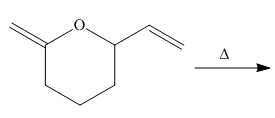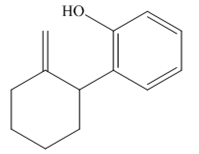
Concept explainers
Draw the products of each reaction.
a. c.
c. 
b. d.
d. 
(a)
Interpretation: The product formed for the given reaction is to be drawn.
Concept introduction: Curved arrows aid in determining the movement and flow of electrons in the reaction. The electrons that take part in the chemical reactions are shown by the curved arrows.
In the sigmatropic rearrangement, the rearrangement of pi bond and the breaking of sigma bond take place. This results in the generation of new sigma bond in the product. In this type of rearrangement, the number of pi bonds remains constant in the reactant as well as in the product.
Answer to Problem 27.52P
The product formed for the given reaction is

Explanation of Solution
The given reaction is shown below.

Figure 1
The product formed for the given reaction is shown below.

Figure 2
In the given reaction, curved arrows shows the movement of pi bonds to give the final product. In this type of reaction, the compound undergoes to the
Thus, the name of product formed is
The product formed for the given reaction is
(b)
Interpretation: The product formed for the given reaction is to be drawn.
Concept introduction: Curved arrows aid in determining the movement and flow of electrons in the reaction. The electrons that take part in the chemical reactions are shown by the curved arrows.
In the sigmatropic rearrangement, the rearrangement of pi bond and the breaking of sigma bond take place. This results in the generation of new sigma bond in the product. In this type of rearrangement, the number of pi bonds remains constant in the reactant as well as in the product.
Answer to Problem 27.52P
The product formed for the given reaction is

Explanation of Solution
The given reaction is shown below.

Figure 3
The product formed for the given reaction is shown below.

Figure 4
The first step in the given reaction is the formation of enolate ion. The curved arrows show the movement of pi bonds to give the final product. In the next step, the compound undergoes to the
Thus, the product formed for the given reaction is
The product formed for the given reaction is
(c)
Interpretation: The product formed for the given reaction is to be drawn.
Concept introduction: Curved arrows aid in determining the movement and flow of electrons in the reaction. The electrons that take part in the chemical reactions are shown by the curved arrows.
In the sigmatropic rearrangement, the rearrangement of pi bond and the breaking of sigma bond take place. This results in the generation of new sigma bond in the product. In this type of rearrangement, the number of pi bonds remains constant in the reactant as well as in the product.
Answer to Problem 27.52P
The product formed for the given reaction is

Explanation of Solution
The given reaction is shown below.

Figure 5
The product formed for the given reaction is shown below.

Figure 6
In the given reaction, curved arrows shows the movement of pi bonds to give the final product. In this type of reaction, the compound undergoes to the
Thus, the name of product formed is
The product formed for the given reaction is
(d)
Interpretation: The product formed for the given reaction is to be drawn.
Concept introduction:
Answer to Problem 27.52P
The product formed for the given reaction is,

Explanation of Solution
The given reaction is shown below.

Figure 7
The molecular formula of the product is
The product formed for the given reaction is shown below.

Figure 8
The given reactant undergoes
The product formed for the given reaction is shown in Figure 8.
Want to see more full solutions like this?
Chapter 27 Solutions
Organic Chemistry
- Calculate the pH and the pOH of each of the following solutions at 25 °C for which the substances ionize completely: (a) 0.000259 M HClO4arrow_forwardWhat is the pH of a 1.0 L buffer made with 0.300 mol of HF (Ka = 6.8 × 10⁻⁴) and 0.200 mol of NaF to which 0.160 mol of NaOH were added?arrow_forwardDetermine if the following salt is neutral, acidic or basic. If acidic or basic, write the appropriate equilibrium equation for the acid or base that exists when the salt is dissolved in aqueous solution. If neutral, simply write only NR. Be sure to include the proper phases for all species within the reaction. NaN₃arrow_forward
- A. Draw the structure of each of the following alcohols. Then draw and name the product you would expect to produce by the oxidation of each. a. 4-Methyl-2-heptanol b. 3,4-Dimethyl-1-pentanol c. 4-Ethyl-2-heptanol d. 5,7-Dichloro-3-heptanolarrow_forwardWhat is the pH of a 1.0 L buffer made with 0.300 mol of HF (Ka = 6.8 × 10⁻⁴) and 0.200 mol of NaF to which 0.160 mol of NaOH were added?arrow_forwardCan I please get help with this.arrow_forward
- Determine if the following salt is neutral, acidic or basic. If acidic or basic, write the appropriate equilibrium equation for the acid or base that exists when the salt is dissolved in aqueous solution. If neutral, simply write only NR. Be sure to include the proper phases for all species within the reaction. N₂H₅ClO₄arrow_forwardPlease help me with identifying these.arrow_forwardCan I please get help with this?arrow_forward
 Organic ChemistryChemistryISBN:9781305580350Author:William H. Brown, Brent L. Iverson, Eric Anslyn, Christopher S. FootePublisher:Cengage Learning
Organic ChemistryChemistryISBN:9781305580350Author:William H. Brown, Brent L. Iverson, Eric Anslyn, Christopher S. FootePublisher:Cengage Learning Organic Chemistry: A Guided InquiryChemistryISBN:9780618974122Author:Andrei StraumanisPublisher:Cengage Learning
Organic Chemistry: A Guided InquiryChemistryISBN:9780618974122Author:Andrei StraumanisPublisher:Cengage Learning

